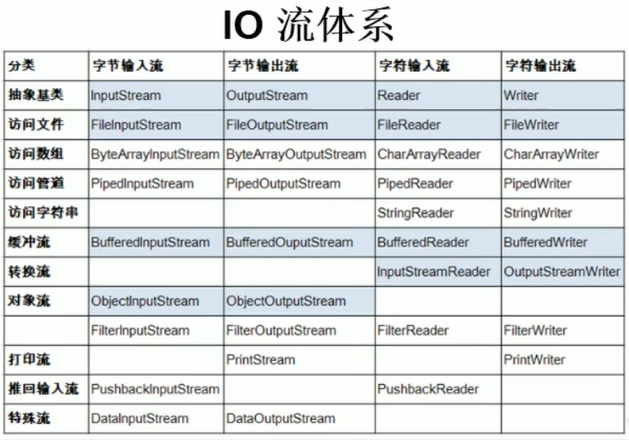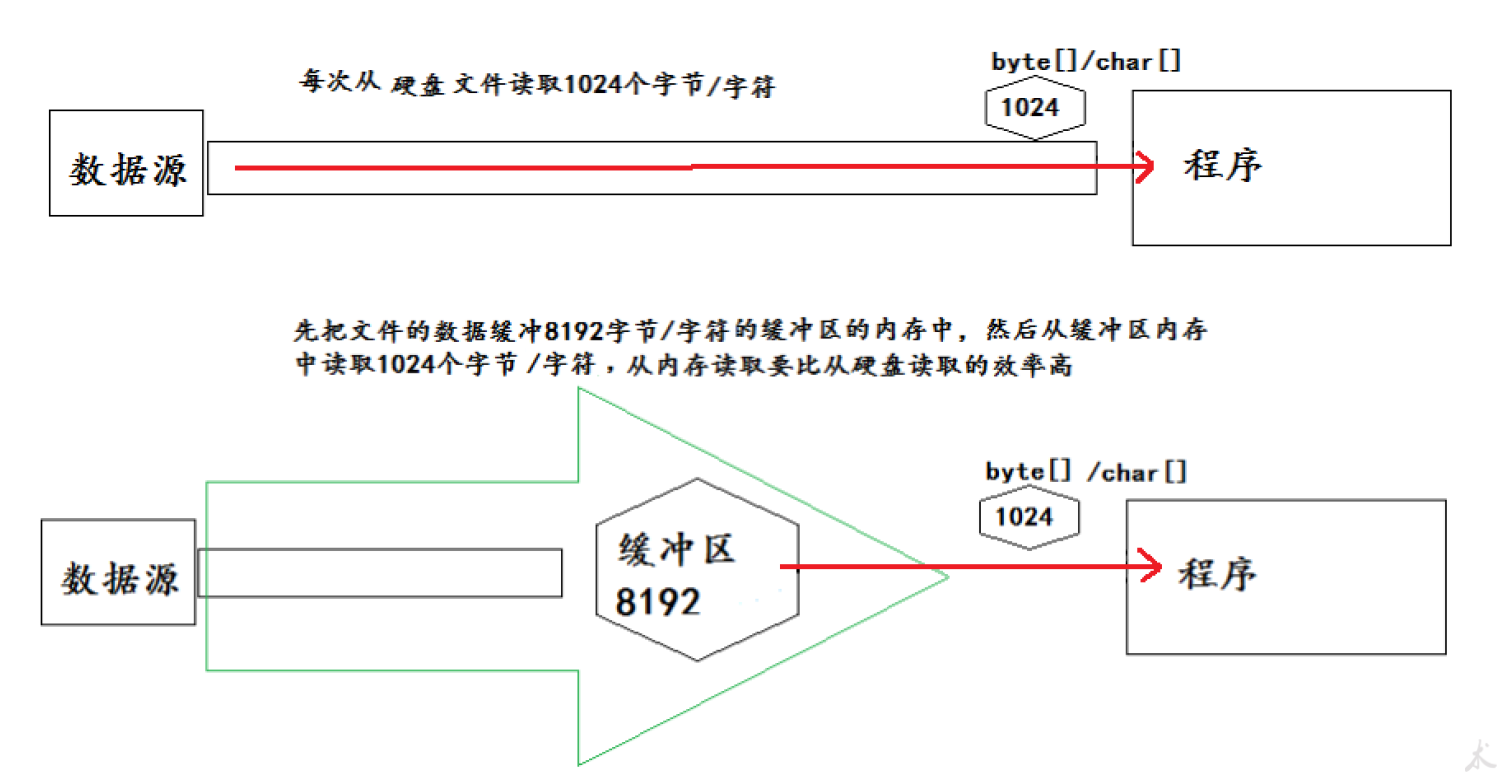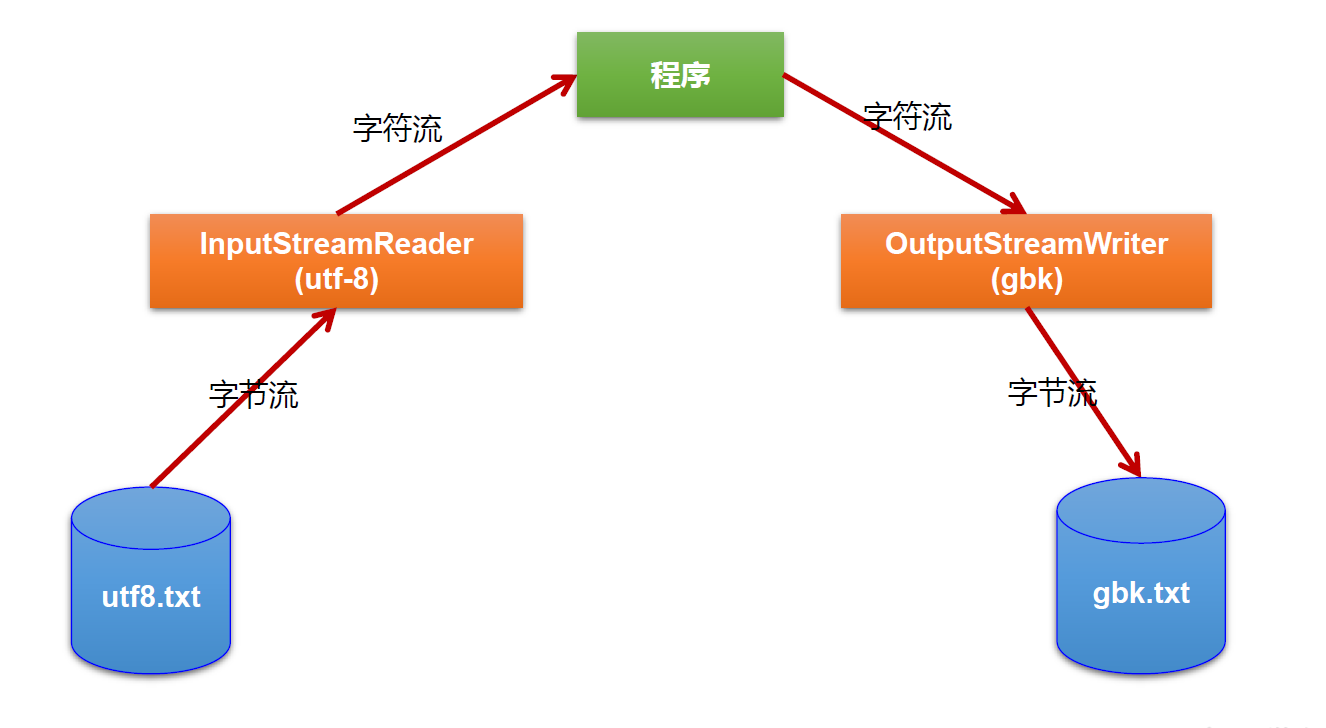Java IO流
I/O流

按照流向可以分为输入流和输出流;按照操作单元来分的话,可以分为字节流和字符流;按照流的角色来划分的话,可以划分为节点流和处理流;
- InputStream(输入)/Reader(读入):所有的输入流的基类,前者是字节输入流,后者是字符输入流。
- OutputStream(输出)/Writer(写出):所有输出流的基类,前者是字节输出流,后者是字符输出流。

节点流
直接从数据源或者目的地读写数据;

节点流(文件流)
节点流的作用在于将一个已存在的文件,加载到程序中,从而进行操作,或者写出流到文件中;
读取文件
// 1、建立一个流对象,将一个已经存在的文件加载进流
FileReader fr = new FileReader("hello.txt");
// 2、创建一个临时存放数据的数组
char [] buffer = new char[1024];
// 3、用数组盛放入进来的文件流
fr.read(buffer);
// 4、关闭资源
fr.close();
代码:
FileReader fr = null;
try{
// 这里需要注意的是,当在 main 方法中时,那么我们的当前路径就是当前的工程路径;
// 如果是单元测试方法,那么当前路径就是相对于我们当前 model 的;
fr = new FileReader("C:\\hello.txt");
char [] buffer = new char[1024];
int len;
while ((len = fr.read()) != -1){
System.out.println(new String(buffer,0,len));
}catch(IOException e){
System.out.println("捕获异常:" + e.getMessage());
}finally{
if(fr != null){
try{
fr.close();
}catch(IOException e)
System.out.println("捕获异常:" + e.getMessage());
}
}
}
写入文件
定义文件路径时,可以使用"/"或者"\"。 在写入一个文件时,使用构造器 FileOutputStream(file),则会覆盖写文件;使用构造器 FileOutputStream(file,true),则会追加文件内容。
// 1、创建流对象,建立数据存放文件
FileWriter fw = new FileWriter("hello.txt");
// 2、调用流对象的写入方法,将文件写入流
fw.write("hello java,hello world");
// 3、关闭资源文件,并将流中的数据清空到文件中
// fw.flus();
fw.close();
代码:
FileWriter fw = null;
try{
fw = new FileWriter("hello.txt");
fw.write("hello world");
}catch(Exception e){
e.printStackTrace();
}finally{
try{
if(fw != null){
fw.close();
}
}catch(IOException e){
System.out.println(e.getMessage());
}
}
处理流
不能直接连接到数据源或目的地,而是“连接”在已存在的流(节点流或处理流)之上,通过对数据的处理为程序提供更为强大的读写功能;

处理流之缓冲流
缓冲流要套接在相应的节点流之上,根据数据操作单位可以把缓冲流分为
BufferedInputStream和
BufferedOutputStream、
BufferedReader和
BufferedWriter。为了提高读写的速度,在使用这些流类的时候,会创建一个内部缓冲区数组,默认使用 8 k大小的缓冲区。缓冲流要套接在相应的节点流上。
- 当使用 BufferedInputStream 读取文件的时候,他会一次性在文件中读取 8 K大小的字节,存到缓冲区,缓冲区满的时候,才从文件中读取下一个 8 K;
- 向文件中写入数据字节时,不会直接写入,而是先写满缓冲区,再将缓冲区的数据一次性的写到文件中。使用 flush( ) 方法可以一强制将缓冲区的内容全部写入文件;
- 关闭流时,只需要关闭最外层流即可,关闭最外层流也会关闭相对应的内层节点流;
- 如果是带有缓冲区的流对象的 close( ),方法,会在关闭流之前进行刷新缓存区。关闭之后就不能进行写出操作;
图解:
 代码:
代码:
BufferedReader br = null;
bufferedWriter bw = null;
try{
br = new BufferedReader(new FileReader("D:\\hello.txt"));
bw = new BufferedWriter(new FileWriter("D:\\hi.txt"));
String str = null;
while((str = br.readLine()) != null){
bw.write(str);
bw.newLine(); // 写入分隔符
}
bw.flush(); // 刷新缓存区,将缓存区的内容一次性全部写入文件
}catch(IOException e){
System.out.println(e.getMessage());
}finally{
// 关闭资源 在这里关掉最外层的即可
try{
if(br != null){
br.close();
}
}catch(IOException e){
System.out.println(e.getMessage());
}
try{
if(bw != null){
bw.close();
}
}catch(IOexception e){
System.out.println(e.getMessage());
}
}
处理流之转换流
转换流,提供了在字节流和字符流之间的转换方法;
- InputStreamReader:将 InputStream 转换为 Reader,将字节转换为字符;
- OutputStreamWriter:将 Writer 装换为 OutputStream,将字符转换为字节;
字节流中的数据都是字符时,转成字符流操作更高效,我们会经常使用转换流处理文件乱码问题。实现编码和解码功能;

// 构造器 // 输入 public InputStreamReader(InputStream is); public InputStreamReader(InputStream is,"gbk"); // 指定字符集 // 输出 public OutputStreamWirter(OutputStream os); public OutputStreamWirter(OutputStream os,"utf-8"); // 指定字符集
代码
// 文件输入输出流
FileInputStream fis = new FileInputStream("hello.txt");
FileOutputStream fos = new FileOutputStream("helloCopy.txt");
// 处理流-转换流
InputStreamReader isr = new InputStreamReader(fis,"gbk");
OutputStreamWriter osw = new OutputStreamWriter(fos,"utf-8");
// 处理流-缓冲流
BufferedReader br = new BufferedReader(isr);
BufferedWriter bw = new BufferedWriter(osw);
String str = null;
while((str = br.readLine()) != null){
bw.write(str);
bw.newLine();
bw.flush();
}
// 关闭流操作
try{
if(br != null){
br.close();
}
}catch(IOException e){
System.out.println(r.getMessage());
}
try{
if(bw != null){
bw.close();
}
}catch(IOException e){
System.out.println(e.getMessage());
}
System.in 和 System.out 分别代表了系统标准的输入和输出设备,System.in 的类型是 InputStream;System.out 的类型是 PrintStream,是OutputStream 的子类
处理流之对象流
ObjectInputStream 和 ObjectOutputStream ,分别用于反序列化读取和序列化保存基本数据类型或者对象。但是不能序列化 static 或 transient 修饰的成员变量 序列化:可以将任何实现了 Serializable 接口的对象转化为字节数据,使其在保存和传输时可被还原。(实现对象平台无关性) 序列化:写出
ObjectOutputStream oos = new ObjectOutputStream(new FileOutputStream("data.txt"));
Person person = new Person("zhangsan",15);
oos.write(p);
oss.flush();
oss.close();
反序列化:读入
ObjectInputStream ois = new ObjectInputStream(new FileInputStream("data.txt"));
Person person = (Person) ois.readObject();
String str = person.toString();
System.out.println(str);
ois.close();
输入流
InputStream 和 Reader
InputStream 和 Reader 是所有输入流的基类
InputStream 的经典实现是 FileInputStream ,存在的方法有
int read( )以及他的重载形式
int read(byte [ ] b)、
int read(byte [ ] b,int off,int len )等,用来读取字节(非文本文件); Reader 的经典实现就是 FileReader,存在方法有
int read( )、
int read(char [ ] c)、
int read( char [ ] c,int off,int len )用来读取字符;
输出流
OutputStream 和 Writer
OutputStream 和 Writer 是相对应的字节输出流和字符输出流
先 flush( ) 刷新后,再关闭流;flush 操作会刷新输出流并强制写出所有缓冲的输出字节或字符
FileOutputStream,用于写出字节文件(非文本类型文件); FileWriter,用于写出字符类型的文件(文本文件);
- JAVA IO流的应用
- Java IO流之中文乱码
- Java IO流
- java IO流之一 IO流介绍(转载)
- 黑马程序员--java IO流(一)
- Java IO流分析整理
- 黑马程序员_Java IO流(上)
- Java IO流(File概述)
- Java IO流读取文件
- java IO流
- java io流
- java IO流文件的读写具体实例
- java IO流操作inoutstream和outputstream读写操作
- java IO流(java分割、合并任意类型文件)
- Java知识总结----Java IO流(七)
- 揭开Java IO流中的flush()的神秘面纱
- java io流
- Java IO流的一个小工具
- java IO流之一 IO流介绍
- java io流 对文件夹的操作
